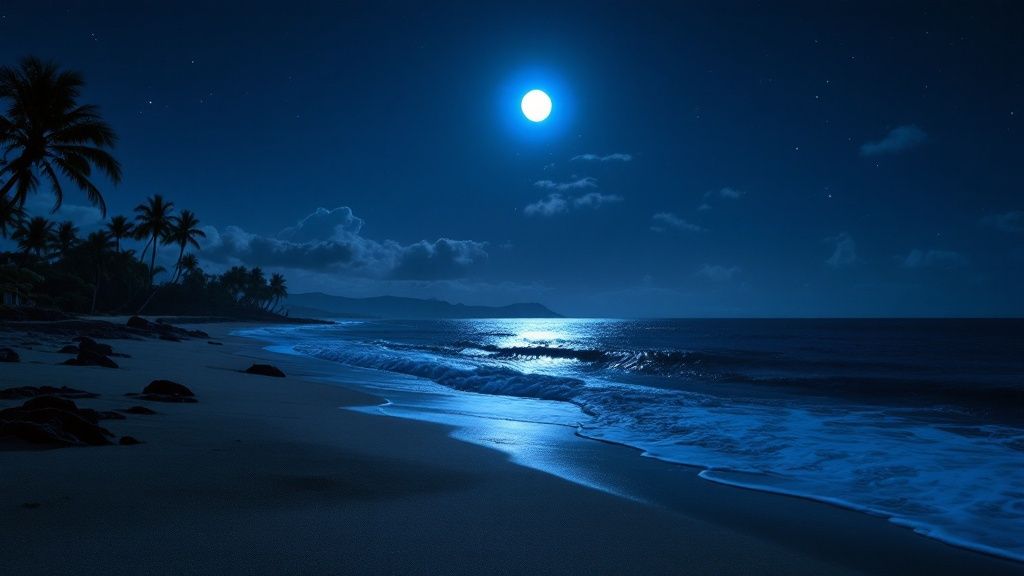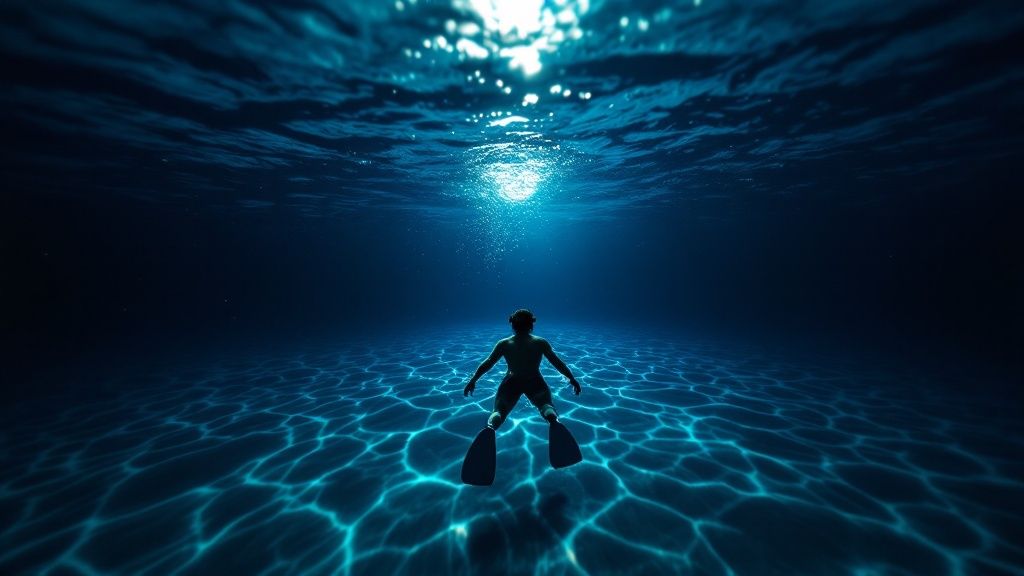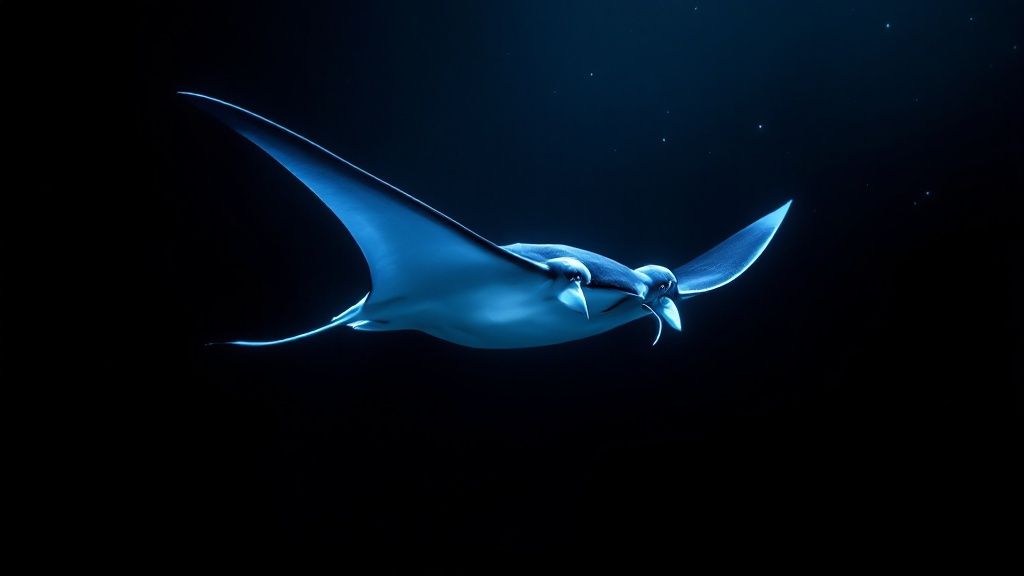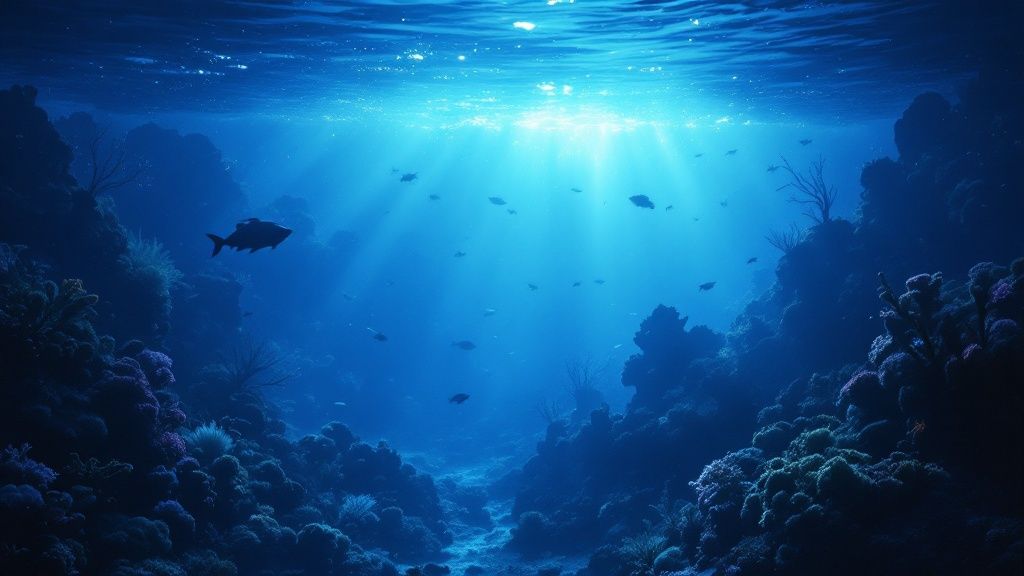Manta Ray Night Snorkel Kona: Unforgettable Adventure

The Magic Behind Kona's Manta Ray Phenomenon

The Kona Coast of Hawaii's Big Island offers a truly special experience: the manta ray night snorkel. What makes this location so captivating? It's not a random encounter, but a mesmerizing natural event orchestrated by the island's volcanic landscape. The underwater formations, carved by ancient lava, create an ideal habitat for plankton, the main food source for manta rays. These nutrient-rich waters flourish with plankton, attracting the majestic mantas for their evening meal.
The Role of Underwater Topography
Volcanic slopes form deep underwater channels and shallow plateaus. This topography is perfect for the upwelling of nutrient-rich water. This process works like a natural elevator, transporting microscopic organisms from the ocean depths to the surface.
Popular snorkel spots like "Manta Village" and "Manta Heaven" are strategically situated near these upwelling zones. This guarantees a steady food supply for the mantas, making these sites predictable viewing locations. The shallow, sandy bottom at these locations offers superb visibility for snorkelers, providing unforgettable close encounters. Remember to be a responsible visitor and learn how to reduce water pollution to protect Kona's marine ecosystem.
The Plankton Dinner Bell
The Kona Coast's allure is enhanced by a unique feeding strategy involving lights. Tour operators use specialized lights to attract plankton, mimicking the natural bioluminescence that draws these organisms to the surface. This creates a "plankton dinner bell," effectively calling the mantas to a captivating feeding display.
Snorkelers can watch these graceful giants filter plankton from the water, often just inches away. The Kona Coast consistently provides remarkable manta ray sightings. From 2009 to 2014, local researchers and underwater videographers diligently documented individual manta rays at "Manta Village" and "Manta Heaven." This included identifying individual mantas, assessing their health, and tracking their movements. The data highlighted a clear pattern: manta rays consistently gather at these feeding areas, particularly when drawn by artificial lights. Learn more about manta ray statistics. For details about our activities, see our sitemap.
Kona vs. Other Manta Hotspots
While other locations around the world offer manta ray viewing, few can rival Kona's consistent sightings and proximity to shore. The predictable feeding behavior and generally calm waters make Kona a perfect spot for both experienced divers and beginner snorkelers. This allows for extended, up-close observation of these gentle giants in their natural environment, an experience that truly distinguishes Kona.
The Night Snorkel Experience: What Really Happens

A manta ray night snorkel in Kona isn't just about getting wet; it's a well-planned adventure. Every detail, from the initial briefing to the magical encounter in the water, enhances the enjoyment and respect for these gentle giants. Let's explore what a typical manta ray night snorkel adventure in Kona holds.
From Shore to Sea: The Journey Begins
Your Kona manta ray adventure begins with a thorough briefing on shore. Expert guides explain the process, emphasizing safety protocols and proper manta ray etiquette. This ensures everyone understands responsible interaction with the mantas. For more insights, check out this resource: How to master…. A short boat trip follows, transporting you to renowned snorkel sites like "Manta Village" or "Manta Heaven." These locations are known for consistent manta ray activity and calm waters, making them perfect for all skill levels, including beginners.
The "Plankton Dinner Bell": Lighting the Way
Upon arrival, guides deploy specialized lights. These aren't just for visibility; they play a key role in attracting plankton. The lights act like a "plankton dinner bell," drawing the tiny organisms, which, in turn, entice the manta rays to a readily available feast. This sets the stage for an incredible spectacle.
In the Water: A Magical Encounter
Snorkelers enter the water, typically holding onto a lighted flotation device. This offers stability and ideal positioning for optimal manta ray viewing. As the mantas arrive, their graceful feeding dance begins, often just inches below the surface. Witnessing these magnificent creatures filter plankton is a breathtaking sight. Their impressive wingspans create an unforgettable ballet in the moonlit water.
Addressing Common Concerns
First-time snorkelers often have questions. Will the water be too cold? What if I'm not a strong swimmer? Reputable tour operators address these concerns by providing wetsuits and flotation devices for comfort and safety. Trained guides assist snorkelers of all abilities, ensuring a comfortable experience. Furthermore, Kona manta ray night snorkel tours boast high success rates, with sightings occurring on most trips.
To help you prepare, here's a handy table outlining what to expect:
Before we dive into the table, remember that packing the right gear can greatly enhance your experience. Let's clarify what you should bring and what will be provided.
| Item | Typically Provided | Bring Yourself | Notes |
|---|---|---|---|
| Wetsuit/Flotation Device | Yes | Optional | Most operators provide these, but you may bring your own for a personalized fit. |
| Snorkel Gear (Mask, Snorkel, Fins) | Yes | Optional | Provided gear is usually sanitized and in good condition, but feel free to bring your own if preferred. |
| Towel | Sometimes | Recommended | Although some operators might provide towels, it's always a good idea to bring your own. |
| Waterproof Camera | No | Highly Recommended | Capture those unforgettable manta ray encounters! |
| Reef-Safe Sunscreen | No | Essential | Protect your skin and the coral reef. |
| Seasickness Medication | No | Consider if prone to seasickness | The boat ride is usually short, but it's better to be prepared. |
| Underwater Flashlight | No | Optional | For personal use if desired. Be mindful of other snorkelers. |
This table highlights the essential items provided by tour operators and what you should bring to ensure a smooth and enjoyable experience. Being prepared allows you to focus on the magic of the manta rays.
Now you have a clearer picture of what to expect on your manta ray night snorkel adventure. It's an experience that will stay with you long after you leave the water.
Timing Your Manta Magic: Seasons, Moon Phases & Tides

Planning your manta ray night snorkel adventure in Kona is key to an unforgettable experience. While these gentle giants grace Hawaiian waters year-round, several factors affect their visibility and behavior. Understanding these elements, such as seasonal changes, moon phases, and tidal shifts, can significantly enhance your chances of a magical encounter.
Seasonal Variations: Summer vs. Winter
Summer, spanning from April to October, typically brings calmer seas and a surge in plankton, the manta ray's primary food source. This means more predictable sightings and clearer waters for optimal viewing. However, this is also the peak tourist season, so expect more crowded tours.
Winter, from November to March, can bring rougher seas, potentially impacting visibility and even leading to tour cancellations. The upside? Fewer crowds, providing a more intimate experience for those who don't mind the potential chill. It's a trade-off: summer's reliability versus winter's personalized touch. For more trip planning tips, check out How to master….
The Lunar Effect: Visibility and Feeding Patterns
Believe it or not, the moon phase plays a significant role in Kona manta ray night snorkels. A new moon creates a darker backdrop, making the lights used to attract plankton more effective. This draws in larger numbers of manta rays, leading to spectacular feeding displays.
In contrast, a full moon diminishes the lights' impact, potentially resulting in fewer sightings. So, consider the lunar cycle when scheduling your adventure.
Tides and Currents: Creating Optimal Feeding Conditions
Tides and currents also influence manta ray activity. Incoming tides often carry nutrient-rich water closer to shore, creating a feast for mantas. Planning your snorkel around incoming tides can increase your chances of a memorable encounter.
The interplay of these natural forces creates the perfect setting for the manta ray's mesmerizing dance. The Kona manta ray night snorkel has gained global popularity. By 2015, at least 42 commercial tour operators were offering these excursions on the Big Island, primarily in Makako Bay and Keauhou Bay, known for their clear waters, sandy slopes, and plentiful plankton. Find more detailed statistics here. These locations are ideal for attracting mantas with carefully implemented lighting systems, especially during the peak viewing season of summer. This growth reflects the high demand for this unique experience and highlights the importance of sustainable tourism in managing this burgeoning interest.
Selecting Your Perfect Manta Adventure Partner

With so many tour operators offering manta ray night snorkeling in Kona, picking the right one can be a real challenge. Knowing the key differences, though, can make all the difference in having an unforgettable experience. It's not just about the cost; things like group size, how comfortable the boat is, the guide's expertise, and the operator's dedication to conservation are important factors to consider.
Beyond the Price Tag: What Truly Matters
The price of a manta ray night snorkel tour usually reflects the overall quality you can expect. Budget tours might overcrowd boats, leaving less personal space and possibly affecting the manta rays’ natural behavior. Premium tours, on the other hand, often focus on smaller groups, creating a more intimate experience with more personalized interactions with the mantas.
Vessel comfort also varies significantly. Larger, more stable catamarans provide a smoother ride with additional amenities, while smaller boats will get you to the snorkel site faster. This can be a key factor if you're prone to seasickness. If you’re curious about other ocean activities Kona has to offer, take a look at our sitemap.
Guide Expertise and Conservation Credentials
Experienced guides can elevate your manta ray encounter significantly. They can identify individual manta rays, interpret their behaviors, and teach you about the local ecosystem. They're also skilled at anticipating the mantas’ movements, getting snorkelers into the best viewing positions while still being respectful of the animals’ space.
When you're researching tours, ask about the guides' experience and commitment to sustainable tourism. A reputable operator prioritizes the well-being of the manta rays and actively supports conservation efforts.
Speaking of reputable operators, the success rate for manta ray sightings on Kona Coast night snorkel tours is remarkably high. Operators like Jack's Diving Locker report seeing manta rays on roughly 85-90% of their trips. This high success rate is thanks to the Kona Coast's unique environment, which creates ideal feeding grounds. Many operators also offer a “Manta Guarantee,” allowing you to rebook if you don't see any mantas on your first trip.
Enhancing Your Experience: Special Offerings
Some tour operators go the extra mile with things like hydrophones, so you can listen to the mantas communicating underwater, or underwater photographers to capture professional photos of your experience. These extras can definitely enhance your trip, but weigh them against your interests and budget. The heart of the experience lies in the magical interaction with the manta rays, so prioritize operators that create safe and respectful encounters. For more helpful tips, you might want to check out our resources.
To help you choose the right tour operator, we've compiled a comparison table highlighting key features and price differences.
To help you make the best decision for your manta ray adventure, the table below compares key features and costs across different tour options.
Manta Ray Tour Operator Comparison
Comparison of key features across different price points for Kona manta ray night snorkel tours
| Feature | Budget Tours ($80-100) | Mid-Range Tours ($100-150) | Premium Tours ($150+) |
|---|---|---|---|
| Group Size | Larger (20+) | Medium (10-20) | Smaller (6-10) |
| Vessel Type | Smaller Boat | Mid-Sized Boat/Catamaran | Larger Catamaran |
| Guide Experience | Varies | Experienced | Highly Experienced/Specialized |
| Amenities | Basic Snorkel Gear | Snorkel Gear/Light Refreshments | High-Quality Gear/Food/Drinks |
| Extras | Rarely | Sometimes (e.g., Hydrophone) | Often (e.g., Photography, Hydrophone) |
As you can see, while budget tours offer a lower entry point, mid-range and premium tours often provide a more enhanced and intimate experience, justifying the higher price tag for many.
Choosing Wisely: Questions to Ask
Before booking, ask potential operators about their group size limits, what type of vessel they use, their guides’ experience, their conservation practices, and what’s included in the tour. These questions will help you understand the operator's commitment to both your satisfaction and the well-being of the manta rays. Choosing an operator aligned with your values ensures you’re contributing to the long-term health of these incredible creatures and their ocean home, all while making unforgettable memories.
From Nervous to Natural: Preparing for Oceanic Magic
Trading pre-trip anxieties for excitement is essential to fully enjoying your manta ray night snorkel adventure in Kona. This guide offers practical preparation tips for all experience levels, addressing common concerns from seasickness to capturing amazing underwater footage.
Taming the Butterflies: Addressing Common Anxieties
Many first-time snorkelers experience some anxiety about nighttime ocean excursions. This is perfectly understandable. Rest assured, Kona's manta ray tours prioritize safety and comfort. Reputable operators provide wetsuits and flotation devices, enabling even non-swimmers to participate fully. Experienced guides are on hand to assist snorkelers of all skill levels, creating a welcoming and supportive atmosphere.
For those prone to seasickness, consider taking over-the-counter medications like Dramamine or motion sickness patches before embarking on the short boat ride to minimize any potential discomfort.
Gear Up for Success: Essential Equipment and Comfort Tips
While tour operators provide the necessary snorkel gear, bringing your own can significantly enhance your comfort and familiarity in the water. A well-fitting mask and snorkel are paramount for clear underwater views and effortless breathing. Bringing your own wetsuit, if you have one, ensures a personalized fit, maximizing warmth and freedom of movement. Don't forget to pack a towel and a change of clothes for post-snorkel comfort.
Before your trip, practice with your snorkel gear in a pool or calm shallows. This helps boost your water confidence and familiarize yourself with the equipment. Even a few practice sessions can dramatically reduce pre-trip jitters.
Capturing the Magic: Photography Tips and Protecting Electronics
Underwater cameras, particularly GoPros, are excellent for documenting your manta ray encounter. Ensure your camera is securely fastened to a float or wrist strap to avoid disturbing the mantas or fellow snorkelers. Keeping the camera close to your body helps prevent accidental contact with the rays.
Safeguarding your electronics is crucial. Waterproof bags or cases provide an added layer of defense against splashes and accidental submersion. Remember to thoroughly dry your equipment after each use to prevent water damage.
Specialized Advice: Families, Seniors, and Specific Concerns
Families with young children should look for tour operators with experience in working with kids. These tours often have smaller groups and guides trained to engage younger snorkelers. Discussing any specific needs or concerns with the operator beforehand is always recommended.
For seniors, tours with easy water entry and exit points are ideal. Some operators provide ramps or steps to assist with getting in and out of the water.
Individuals with specific comfort concerns, such as a fear of the dark or deep water, should communicate these to the tour operator. Reputable companies will offer personalized support and guidance to ensure a positive and enjoyable experience for everyone. This might involve staying closer to the boat, having a dedicated guide nearby, or even observing the mantas from the boat itself. Open communication is key to a memorable experience.
Swimming With Giants: The Conservation Connection
Your manta ray night snorkel Kona experience is more than just a memorable vacation moment. It's a chance to become part of a vital conservation effort. This incredible adventure directly connects you to global manta conservation work, showing how sustainable tourism plays a key role in protecting these magnificent and vulnerable creatures. Before you jump in, it's wise to brush up on snorkeling safety tips.
From Threat to Ally: How Tourism Protects Mantas
Tourism wasn’t always seen as a positive force for manta rays. In the past, it was often considered a potential threat. However, the story in Kona has changed significantly. Thanks to collaboration between researchers, conservationists, and tour operators, tourism now plays a critical role in protecting these animals. This shift highlights how responsible tourism can positively impact vulnerable wildlife.
Identification Programs: Tracking Gentle Giants
A key component of manta ray conservation in Kona is the use of identification programs. Led by dedicated researchers and citizen scientists, these programs use the unique spot patterns on each manta's belly – much like a fingerprint – to track individuals. This allows researchers to gather essential data about their movements, behaviors, and overall population dynamics. You might even see some familiar faces like "Koie" or "Lefty"!
Visitor Contributions: The Power of Your Photographs
As a visitor, you can play a direct role in these research initiatives. Your photos, especially clear images of the manta’s underside, can be extremely helpful. Sharing your pictures with local research organizations allows you to participate in population monitoring. This citizen science approach greatly increases the available data, contributing to more effective conservation strategies. You might also be interested in learning more about photography techniques: How to master…
Sustainable Practices: Balancing Accessibility and Protection
The development of sustainable practices within Kona's manta ray tourism demonstrates the commitment of local operators. From eco-friendly lights to minimizing disruptions, tour providers constantly refine their approaches to protect the mantas’ well-being. They also carefully manage group sizes and adhere to strict interaction guidelines. This careful balance between accessibility and protection is fundamental to responsible manta ray tourism in Kona.
The Broader Impact: Kona's Role in Global Conservation
Kona's conservation efforts extend far beyond Hawaii. The information collected here contributes to a global understanding of manta ray behavior and population trends, which helps shape international conservation strategies. Kona serves as a model for sustainable manta ray tourism, showing how responsible practices can benefit both local economies and this vulnerable species. Your manta ray night snorkel Kona adventure helps protect these magnificent creatures worldwide.
Your Choices Matter: Directly Impacting Manta Welfare
Your decisions as a visitor have a direct impact on manta ray well-being. Choosing a reputable tour operator dedicated to sustainable practices supports responsible tourism and vital conservation efforts. By being mindful of your actions in the water – avoiding touching the mantas and respecting their space – you minimize your impact and help safeguard these gentle giants for future generations.
Book your unforgettable manta ray night snorkel adventure with Kona Snorkel Trips today! Experience the wonder of these gentle giants and contribute to ongoing sustainable tourism and conservation initiatives. Explore our tours and book your adventure now!
